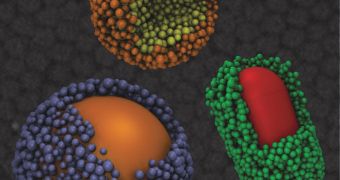Physicists at the University of Michigan, in the United States, recently managed to develop a new method for producing uniform superclusters of nanoparticles. Their approach resembles a balancing act performed at the nanoscale, as it involves using a careful balance of atomic forces.
Despite the difficulties, the overall result is amazing – the team can produce large, uniform blocks of nanoparticles, which are a vital component of numerous nanotechnology-based applications in a wide variety of fields of science.
Achieving this type of structure has proven an extremely complex technical challenge, and researchers dabbling in nanotechnology were block from developing new advancements because of this obstacle.
Now that U-M experts cleared the way, new innovations may get underway again. The team explains that it drew inspiration from nature in order to develop the new production technique. Viruses were their main source of data, the investigators added.
In many ways, the nanoparticle superclusters resemble viruses. Even the mechanisms that are using to bring the building blocks together are inspired by the processes that viral agents used to bring their own bringing blocks into contact.
The new study – details of which were published in the latest online issue of the top scientific journal Nature Nanotechnology – was led by U-M chemical engineering professors Nicholas Kotov and Sharon Glotzer.
“The breakthrough here is that we've discovered a generic mechanism that causes these nanoparticles to assemble into near perfect structures,” Glotzer explains. He adds that an interplay of electrostatic repulsion forces and van der Waals forces is used to limit the growth of nanoclusters.
“The physics that we see is not special to this system, and could be exploited with other materials. Now that we know how it works, we can design new building blocks that will assemble the same way,” the investigator goes on to say.
He adds that the two forces tend to balance each other out at some point. The approach only functions if the experts start with nanoparticles of inconsistent sizes. If the particles have the same size and mass, then it is impossible to aggregate them into superclusters using this method.
“Having these functionalities in totally inorganic system is quite remarkable. There is the potential to combine them with the beneficial properties of inorganic materials such as environmental resilience, light adsorption and electrical conductivity,” Kotov concludes.
The new investigation was made possible by funds secured from the US National Science Foundation (NSF), the Department of Defense (DoD), and the US Army Research Office.

 14 DAY TRIAL //
14 DAY TRIAL //